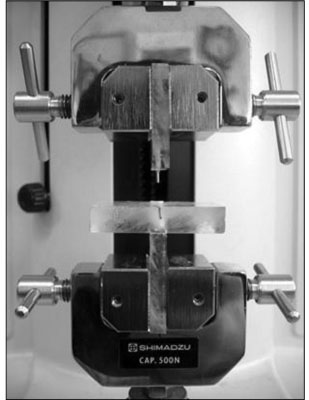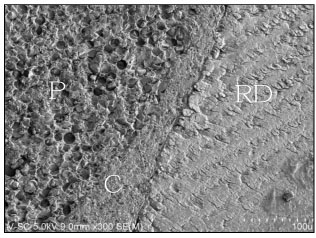Articles
- Page Path
- HOME > Restor Dent Endod > Volume 34(2); 2009 > Article
- Original Article Effect of curing methods of resin cements on bond strength and adhesive interface of post
- Mun-Hong Kim, Hae-Jung Kim, Young-Gon Cho
-
2009;34(2):-112.
DOI: https://doi.org/10.5395/JKACD.2009.34.2.103
Published online: March 31, 2009
Department of Conservative Dentistry, Colledge of Dentistry, Chosun University, Korea.
- Corresponding Author: Young-Gon Cho. Department of Conservative Dentistry, Chosun University, 421 Seosuk-dong, Dong-gu, Gwangju 501-825, Korea. Tel: 82-62-220-3840, Fax: 82-62-232-9064, ygcho@chosun.ac.kr
• Received: November 20, 2008 • Revised: January 2, 2009 • Accepted: January 12, 2009
Copyright © 2009 The Korean Academy of Conservative Dentistry
- 858 Views
- 3 Download
- 4 Crossref
Abstract
-
The purpose of this study was to compare the effect of curing methods of adhesive resins and resin cements in the root canal. Crown portions of 32 single-rooted mandibular premolars were removed. Routine endodontic treatment was done, and 9 mm deep post spaces were prepared within root canals. No. 3 FRC Postec posts (Ivoclar-Vivadent AG, Liechtenstein) were cemented in the post spaces by self-(SC) or light-curing (LC) using two dual-cured adhesives (Adper Scotchbond multi-purpose plus and Exite DSC )and resin cements (RelyX ARC and Variolink II). They were assigned to 4 groups (n=8); R-SC, R-LC, V-SC, V-LC group.After stored in distilled water for 24 hours, each root was transversally sectioned with 1.5 mm thick and made three slices. The specimens were subjected to push-out test in a universal testing machine (EZ Test, Shimadzu Co., Japan) with a crosshead speed of 1 mm/min. The data were analyzed with repeated ANOVA and one-way.ANOVA. Also the interface of post-resin cement and resin cement-canal wall of each group was observed under FE-SEM.When fiber posts were cemented into the root canal using total-etch adhesives, the bond strength and adaptation between post and root canal dentin was affected by curing method. Self-cure of adhesives and resin cements showed higher bond strength and closer adaptation than light-cure of them.
- 1. Sorensen JA, Engelman MJ. Effect of post adaptation on fracture resistance of endodontically treated teeth. J Prosthet Dent. 1990;64: 419-424.ArticlePubMed
- 2. Vichi A, Grandini S, Davidson CL, Ferrari M. An SEM evaluation of several adhesive systems used for bonding fiber posts under clinical conditions. Dent Mater. 2002;18: 495-502.ArticlePubMed
- 3. Morfis AS. Vertical root fracture. Oral surg Oral Med Oral Pathol. 1990;69: 631-635.PubMed
- 4. Lassila LVJ, Tanner J, Bell AM, Narva KN, Vallittu PK. Flexural properties of fiber reinforced root canal posts. Dent Mater. 2004;20: 29-36.ArticlePubMed
- 5. Mannocci F, Qualtrough AJ, Worthington HV, Watson TF, Pitt-Ford TR. Randomized clinical comparison of endodontically treated teeth restored with amalgam or fiber posts and resin composite: five year results. Oper Dent. 2005;30: 9-15.PubMed
- 6. Perdigao J, Gomes G, Lee IK. The effect of silane on the bond strengths of fiber posts. Dent Mater. 2006;22: 752-758.ArticlePubMed
- 7. Asmussen E, Peutzfeldt A, Heitmann T. Stiffness, elastic limit, and strength of newer types of endodontic post. J Dent. 1999;27: 275-278.PubMed
- 8. Song MH, Park SJ, Cho HG, Hwang YC, Oh WM, Hwang IN. Influence of adhesive application on shear bond strength of the resin cement to indirect resin composite. J Korean Acad Conserv Dent. 2008;33: 419-427.Article
- 9. Ferrari M, Vichi A, Grandini S. Efficacy of different adhesive techniques on bonding to root canal walls: an SEM investigation. Dent Mater. 2001;17: 422-429.ArticlePubMed
- 10. Bouillaguet S, Troesch S, Wataha JC, Krejci I, Meyer JM, Pashley DH, Microtensile bond. Microtensile bond strength between adhesive cements and root canal dentin. Dent Mater. 2003;19: 199-205.ArticlePubMed
- 11. Escribano N, Macorra JC. Microtensile bond strength of self-adhesive luting cements to ceramic. J Adhes Dent. 2006;8: 337-341.PubMed
- 12. Park JS, Kim JS, Kim MS, Son HH, Kwon HJ, Cho BH. Aging effect on the microtensile bond strength of self-etching adhesive. J Korean Acad Conserv Dent. 2006;31: 415-425.Article
- 13. Oliveira SSA, Pugach MK, Hilton JF, Watanabe LG, Marshall SJ, Marshall GW Jr. a self-etching primer vs a total-etch system. Dent Mater. 2003;19: 758-767.PubMed
- 14. Kim DS, Park SH, Choi GW, Choi KK. The effect of bonding resin on bond strength of dual-cure resin cements. J Korean Acad Conserv Dent. 2007;32: 426-436.Article
- 15. Dallari A, Rovatti A, Dallan B, Mason PN, Suh BI. Translucent quartz-fiber post luted in vivo with selfcuring composite cement: Case report and microscopic examination at a two-year clinical follow-up. J Adhes Dent. 2006;8: 189-195.PubMed
- 16. Monticelli F, Grandini S, Goracci C, Ferrari M. Clinical behavior of translucent fiber posts: a 2-year prospective study. Int J Prosthodont. 2003;16: 593-596.PubMed
- 17. Valandro LF, Filho ODA, Valera MC, de Araujo MAM. The effect of adhesive systems on the pullout strength of a fiberglass-reinforced composite post system in bovine teeth. J Adhes Dent. 2005;7: 331-336.PubMed
- 18. Goracci C, Tavares AU, Fabianelli A. The adhesion between fiber posts and root canal walls: comparison between microtensile and push-out bond strength measurements. Eur J Oral Sci. 2004;112: 353-361.ArticlePubMed
- 19. Valandro LF, Filho ODA, Valera MC, de Araujo MAM. The effect of adhesive systems on the pullout strength of a fiber glass-reinforced composite post system in bovine teeth. J Adhes Dent. 2005;7: 331-336.PubMed
- 20. Goracci C, Fabianelli A, Sadek FT, Papacchini F, Tay FR, Ferrari M. The contribution of friction to the dislocation resistance of bonded fiber posts. J Endod. 2005;31: 608-612.ArticlePubMed
- 21. Magni E, Mazzitelli C, Papacchini F, Radovic I, Goracci C, Coniglio I, Ferrari M. Adhesion between fiber posts and resin luting agents: A microtensile bond strength test and SEM investigation following different treatment of the post surface. J Adhes Dent. 2007;9: 195-202.PubMed
- 22. Arrais CAG, Giannini M, Rueggeberg FA, Pashley DH. Effect of curing mode on micotensile bond strength to dentin of two dual-cured adhesive systems in combination with resin luting cements for indirect restorations. Oper Dent. 2007;32: 37-44.PubMed
- 23. Asmussen E, Peutzfeldt A. Bonding of dual-curing resin cements to dentin. J Adhes Dent. 2006;8: 299-304.PubMed
- 24. Ceballos L, Garrido MA, Fuentes V, Rodriguez J. Mechanical characterization of resin cements used for luting fiber posts by nanoindentation. Dent Mater. 2007;23: 100-105.ArticlePubMed
REFERENCES
Tables & Figures
REFERENCES
Citations
Citations to this article as recorded by 

- Retentive strength of different intracanal posts in restorations of anterior primary teeth: anin vitrostudy
Mahtab Memarpour, Fereshteh Shafiei, Maryam Abbaszadeh
Restorative Dentistry & Endodontics.2013; 38(4): 215. CrossRef - Effect of surface treatment of FRC-Post on bonding strength to resin cements
Chan-Hyun Park, Se-Hee Park, Jin-Woo Kim, Kyung-Mo Cho
Journal of Korean Academy of Conservative Dentistry.2011; 36(2): 125. CrossRef - Effect of surface treatments of fiber posts on bond strength to composite resin cores
Hye-Jo Keum, Hyun-Mi Yoo
Journal of Korean Academy of Conservative Dentistry.2010; 35(3): 173. CrossRef - Comparison of push-out bond strength of post according to cement application methods
Seo-Ryeong Kim, Jiwan Yum, Jeong-Kil Park, Bock Hur, Hyeon-Cheol Kim
Journal of Korean Academy of Conservative Dentistry.2010; 35(6): 479. CrossRef
Effect of curing methods of resin cements on bond strength and adhesive interface of post













Figure 1
Apparatus designed for push-out test
Figure 2
R-SC group(×300). P: post, C: resin cement, RD: root dentin
Figure 3
R-SC group(×1,000). P: post, C: resin cement
Figure 4
R-SC group(×1,000). C: resin cement, RD: root denti
Figure 5
R-LC group(×300). P: post, C: resin cement, RD: root dentin
Figure 6
R-LC group(×1,000). P: post, C: resin cement
Figure 7
R-LC group(×1,000). C: resin cement, RD: root dentin
Figure 8
V-SC group(×300). P: post, C: resin cement, RD: root dentin
Figure 9
V-SC group(×1,000). P: post, C: resin cement
Figure 10
V-SC group(×1,000). C: resin cement, RD: root dentin
Figure 11
V-LC group(×300). P: post, C: resin cement, RD: root dentin
Figure 12
V-LC group(×1,000). P: post, C: resin cement
Figure 13
V-LC group(×1,000). C: resin cement, RD: root dentin
Figure 1
Figure 2
Figure 3
Figure 4
Figure 5
Figure 6
Figure 7
Figure 8
Figure 9
Figure 10
Figure 11
Figure 12
Figure 13
Effect of curing methods of resin cements on bond strength and adhesive interface of post
Resin cements and adhesive systems
Group classification and procedures for post cementation
R: RelyX ARC, V: Variolink II, SC: Self-Cure, LC: Light-Cure, PR: Post Room
Push-out strength (MPa) and statistical comparison
R: RelyX ARC, V: Variolink II, SC: Self-Cure,LC: Light-Cure Same superscript is not statistically different (p > 0.05).
Table 1
Resin cements and adhesive systems
Table 2
Group classification and procedures for post cementation
R: RelyX ARC, V: Variolink II, SC: Self-Cure, LC: Light-Cure, PR: Post Room
Table 3
Push-out strength (MPa) and statistical comparison
R: RelyX ARC, V: Variolink II, SC: Self-Cure,LC: Light-Cure Same superscript is not statistically different (p > 0.05).

 KACD
KACD
















 ePub Link
ePub Link Cite
Cite

